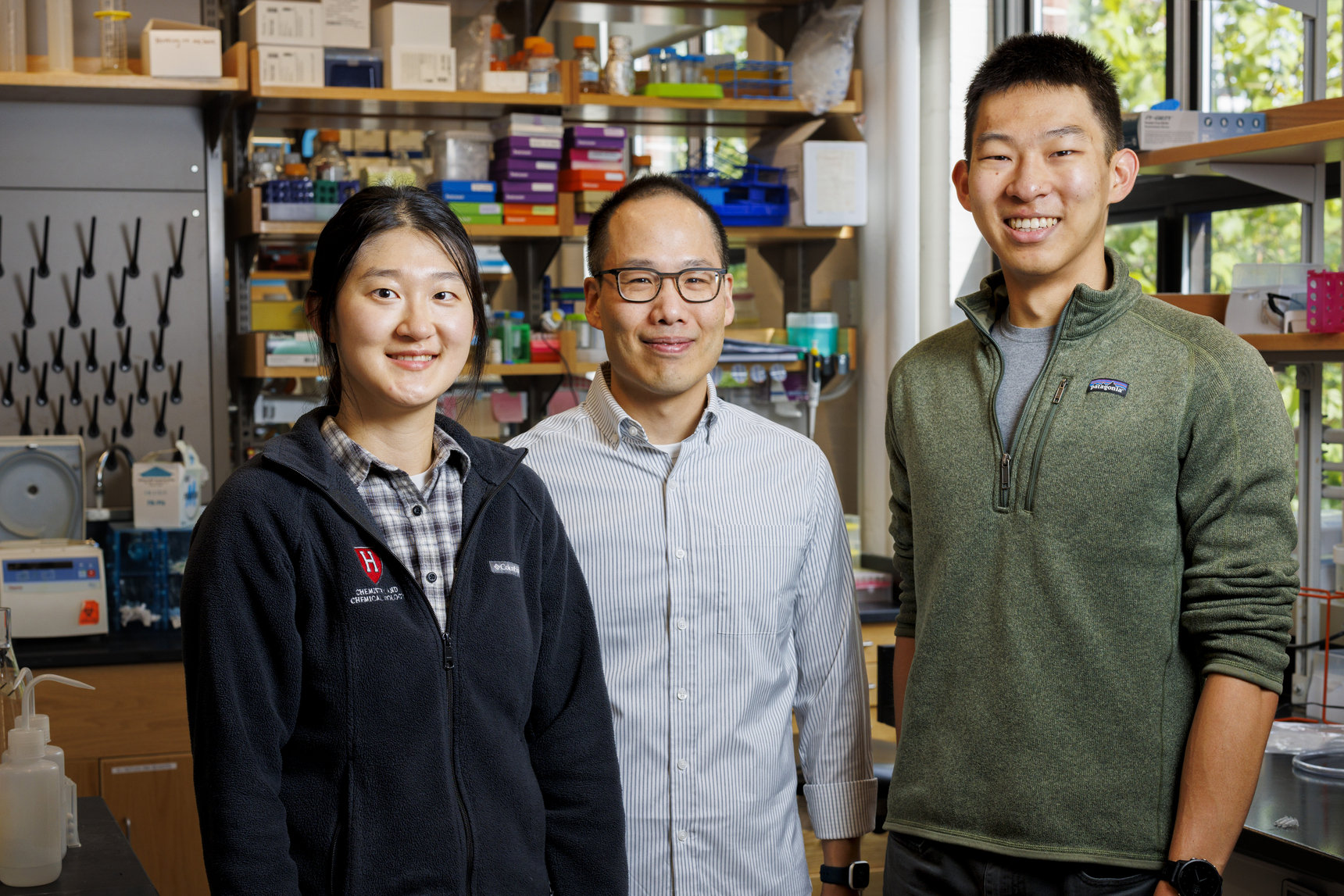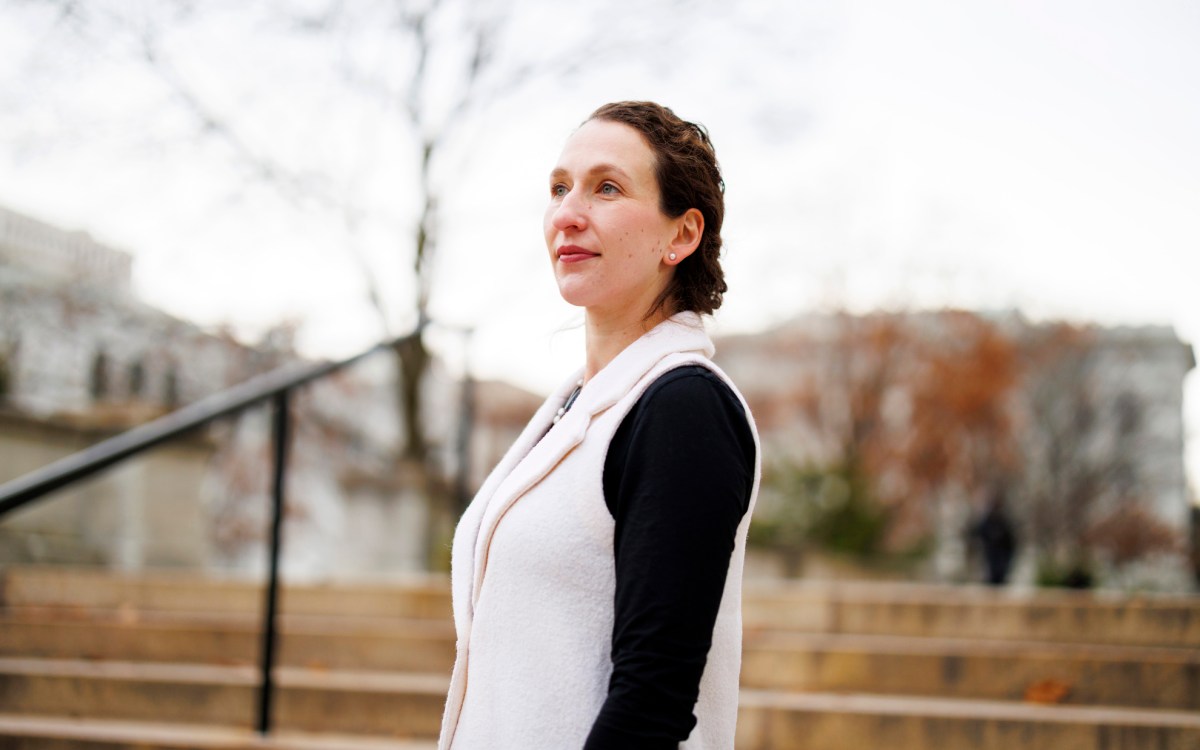Shining a light on the dark matter of our genome
New research unveils powerful mapping tool that may help transform treatment of genetic disease

Heejin Roh (left), Brian Liau, and Simon Shen.
Veasey Conway/Harvard Staff Photographer
Understanding how cells turn genes on and off is one of biology’s most enduring mysteries.
Now, a new technology developed by chemist Brian Liau and his collaborators at Harvard offers an unprecedented window into this activity, an advance that has the potential to transform our understanding of the basic science as well as the treatment of genetic diseases.
In a paper recently published in Nature Methods, the authors unveiled a powerful genome mapping tool that reveals how tiny changes in DNA can reshape the way genes are controlled. This new platform, called TDAC-seq (Targeted Deaminase Accessible Chromatin sequencing), allows researchers to see, at single-nucleotide resolution, how hundreds of genetic perturbations alter the structure of “chromatin” — the dynamic DNA packaging that determines which genes are accessible to the cell’s machinery.
“This new and innovative method is a tour de force, offering an unprecedented view into the DNA elements that govern our genome.”
David Liu
Previously, scientists mostly focused on the tiny portion of DNA that directly creates proteins. Now, TDAC-seq helps them finally study the “dark matter” of our genetic code — the noncoding DNA, which makes up about 98 percent of the genome and helps regulate gene activity.
“This new and innovative method is a tour de force, offering an unprecedented view into the DNA elements that govern our genome,” said David Liu, Thomas Dudley Cabot Professor of the Natural Sciences, whose earlier work on base-editing enzymes helped make this technology possible. “This work will not only speed up our basic understanding of how these switches work but also show us how they could be targeted to benefit patients in the future.”
This research was performed by members of Liau’s lab, including Heejin Roh and Simon Shen, Ph.D. students in the Kenneth C. Griffin Graduate School of Arts and Sciences, and Hui Si Kwok, a postdoctoral scholar. The group collaborated with Jason D. Buenrostro, professor of stem cell and regenerative biology, and his former graduate student Yan Hu, who helped with computational analysis.
The researchers began with a big question: Can we find a way to test hundreds of changes to genetic switches at once and measure their effects in real cells?
“We wanted to develop a strategy where we can systematically mutate these noncoding elements using CRISPR to figure out how they work,” Liau said. “The problem was that we didn’t have the tools to do it, so we had to invent them.”
“Because this is a fundamentally new kind of data set that we’re collecting, it required a fundamentally new way to analyze the data.”
Simon Shen
The Liau Lab’s innovation centered on an enzyme called DddA, found in bacteria, which marks open DNA by converting a single base, cytosine, into thymine — without breaking the DNA strand. By layering these DddA-induced mutations on top of CRISPR-edited DNA, the team developed a new way to read DNA accessibility in cells after CRISPR-genome editing.
“When we started the project, DddA was new and very little was known about it, so boosting its mutation rate in the genome was a big challenge,” Roh said. “We tried different DddA variants and optimized the reaction conditions until we achieved a mutation rate high enough to measure chromatin accessibility at single-molecule resolution.”
Shen, who helped handle the massive amounts of data the new technique generated, noted that innovation was a key to their success.
“Because this is a fundamentally new kind of data set that we’re collecting, it required a fundamentally new way to analyze the data,” Shen said. “Our approach was really good for getting us long, high-coverage reads in the targeted regions and pinpointing key elements within noncoding DNA.”
To demonstrate the power of their tool, the scientists applied it to several regulatory regions, including one that controls fetal hemoglobin — a hotbed for genetic disorders such as sickle cell disease.
By engineering DNA variants in human blood stem cells and applying TDAC-seq, the team tracked exactly how each change affected the surrounding chromatin. Buenrostro, a pioneer in technologies used to map chromatin accessibility, provided invaluable input enabling the team’s success.
“We were able to increase the fetal globin through genome editing, which is the therapeutic strategy to treat sickle cell disease, and then measure the resulting changes in chromatin accessibility to get at the underlying molecular mechanism.”
Heejin Roh
“We were able to increase the fetal globin through genome editing, which is the therapeutic strategy to treat sickle cell disease, and then measure the resulting changes in chromatin accessibility to get at the underlying molecular mechanism.” Roh said. “We also showed that this method can be applied to pooled CRISPR screens in primary cells, unlike other existing long-read sequencing methods.”
TDAC-seq’s importance goes well beyond sickle cell disease. Liau envisions the platform being used in the future to screen potential gene therapy strategies, guide the design of more precise treatments, and even help explain mysterious links between DNA variations and disease risks.
“This can be very impactful because most disease-associated variants are in noncoding regions of the genome,” Liau said, who plans to hone TDAC-seq so it works in even more cell types and situations. “This tool is generalizable, so you can use it to study any kind of switch or a gene that is altered by disease.”
This research was supported by a NIH Maximizing Investigators’ Research Award (MIRA).





